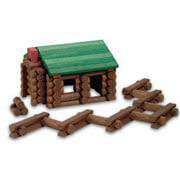If your parents are like mine, they’ve held on to just about every toy you had as a child—whether to remember the days when you were younger, or to have so you can pass them down to their grandchildren one day. But how can you tell if that toy is safe or appropriate for your kids 20-30 years after you first loved it?
Over the past 30 years, the toy industry has changed its standards for safety by leaps and bounds. What was thought as safe in the ’80s wouldn’t necessarily pass by today’s tests and measures. Let’s take toy size for example. Kids back in my day used to play with Jacks, Lincoln Logs, Marble Runs and more. I don’t remember my mom putting them in a container to see if I would choke on it before letting me play. They didn’t worry about what country our toys were made in, only if we liked it and it didn’t cost too much.
Now our parents are probably thinking “Well you survived didn’t you? Your kids will be fine.” I know I’m guilty of thinking this way too, but a lot of parents out there are a bit more concerned. One toy I was nervous about was Little People. Originally, Fisher Price made them small and out of wood—they were essentially basic pegs with some character. They have evolved over the years from those two-toned, round headed pegs into plastic figures that actually resemble little kids. The first time my oldest boy played with the old school Little People I thought nothing of it, but once my second child came around (the one who will put everything under the sun in his mouth). I got a little more worried. These seemed to fit perfectly in his mouth and I was nervous he would choke on them.
I should add that he never did choke on one, nor have any of my kids, but there is always that fear out there. We “modern day” parents hear one story of a kid who got hurt on a toy or product and we instantly want to ban them from our houses and warn the masses. I’m here to tell you, it’s going to be okay. It’s okay for your kids to play with some of your older toys, so long as you inspect them for broken parts, chipping paint, making sure they aren’t too small to choke on for kids under 3 and check that they don’t have any super sharp edges. It’s also okay to let your parents know when you don’t want your kids to play with a certain toy. You can offer to buy a set of toys to keep at the grandparents house for when your kids are over there if it would make you feel better and keep the original toys as a keepsake or get rid of them, as you choose. At the end of the day, you know what is best for your child.
Whether a toy is new out of the box in 2011 or a treasured toy from 30 years ago, the same basic principles and common sense apply. If the toy is in good shape and appropriate for your children’s ages, there’s very little risk, and you and your parents have the pleasure of seeing a new child enjoy something that’s already pre-loved.

